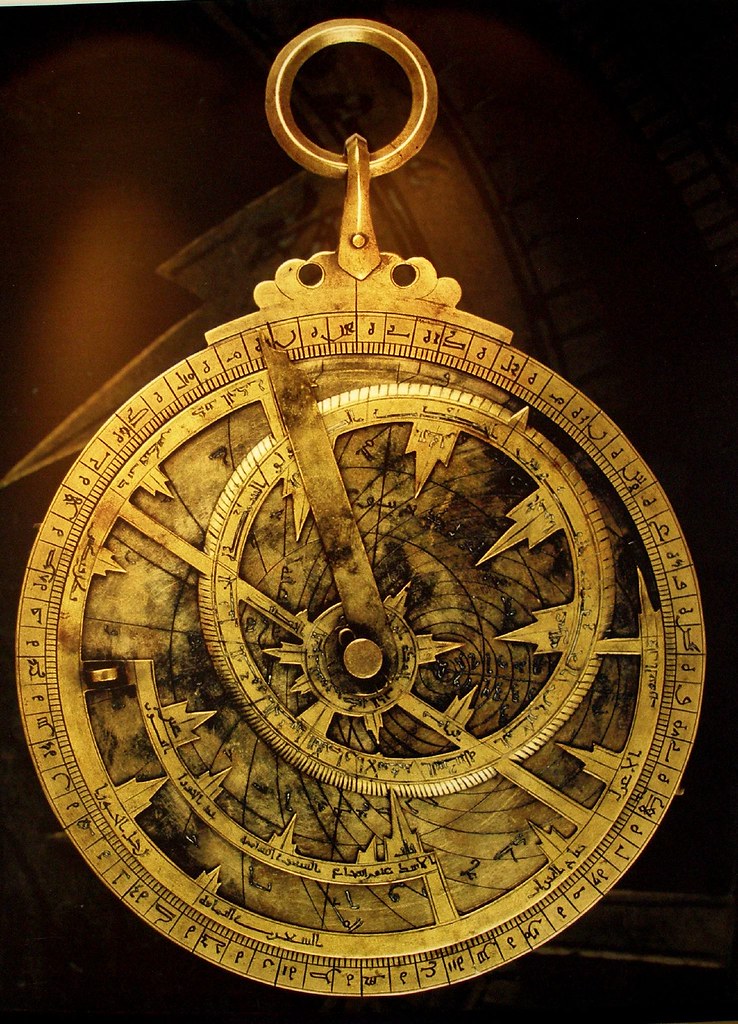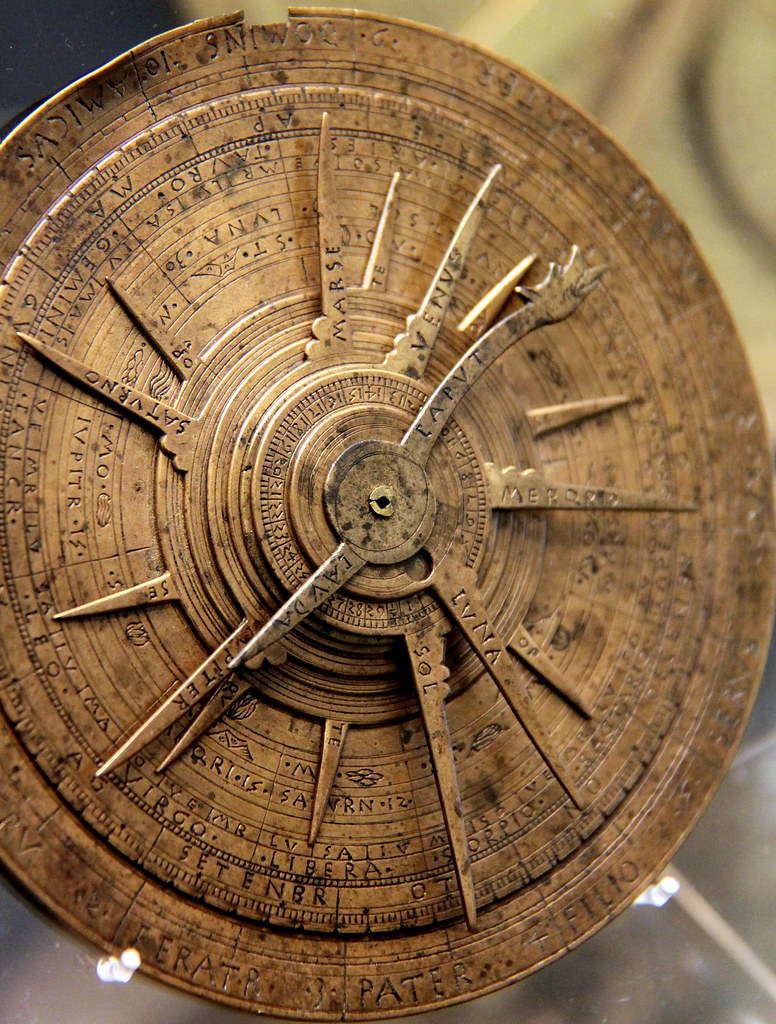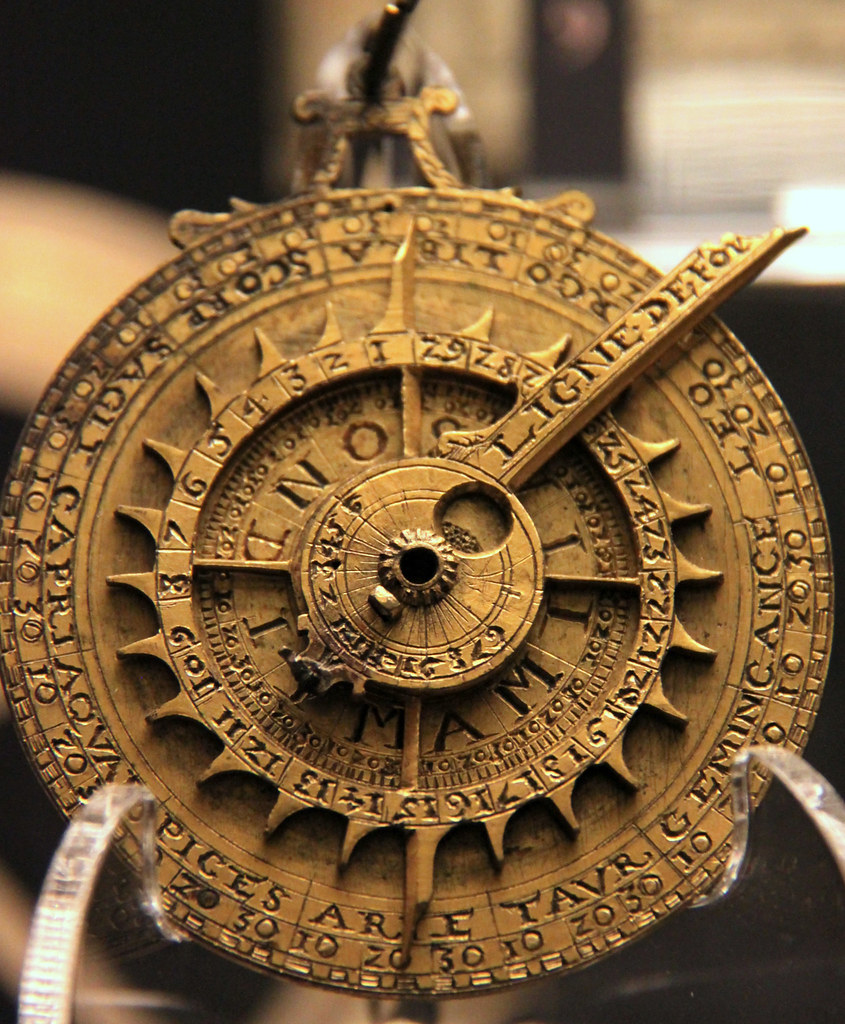23 July 2020
Astrolabe – Magnificent Computer of the Ancients
It is an ancient tool, created over two thousand years ago when people thought that the Earth was the center of the universe. They are often referred to as the first computer and however debatable that statement might be there is one thing for sure without a doubt. Astrolabes are objects of immense mystery and beauty.
So what does an astrolabe do and how were they useful in the ancient world? Firstly they are problem solving instruments – they compute things such as the time of day according the position of the sun and the stars in the sky. Like a computer, you input information and then you receive output. They were typically made of brass and had a 6 inch diameter, although as we will see much larger ones were made.

The sky is drawn on the face of the astrolabe, focusing on the twenty brightest stars. One of the first questions about astrolabes is that if the ancients believed the universe to be earth centered then how did they work as obviously the solar system is helio-centered? Yet the ancients knew the relative sizes of the earth and the sun and the distances between them. Based on what we can see with the eye there is no difference between a helio-centered solar system and one which is believed to be earth centered – at least in terms of the math involved.
Moveable components on the astrolabe are then set to a specific time and date and then the sky is represented on the face of the instrument. What was the point of that? A lot of astronomical problems, some as simple as finding the time of day or night, could be solved with the astrolabe. The ancients were also able to find out what time the sun would rise and set from the astrolabe. You can also work out directions: the astrolabe was invaluable to Muslim scholars as from it they could work out the direction to Mecca.
To describe exactly how an astrolabe works would be pointless – show and tell is a much better way of doing things. Here, in a TED podcast, Tom Wujec reaches back in time to the astrolabe. With thousands of uses, from telling time to mapping the night sky, this old tech reminds us that the ancient can be as brilliant as the brand-new.

As such the astrolabe became one of the fundamental tools for astronomy until the late middle ages. Over the centuries several types of astrolabe were produced, the most common being the planispheric astrolabe where the celestial sphere was projected on to the plane of the equator. The principles of this projection were known well before 150 BC but it is thought that the first functioning one was produced centuries after it was theorised. Certainly, what we recognise as astrolabes had become common instruments of astronomy by 400AD.
The origins of the astrolabe, like so much other science, can be found in classical Greece. We know that it was likely that Apollonius studied astrolabe projection at least two hundred years before the birth of Christ. The theory was later expounded upon by Hipparchus, who was born in Nicaea in Asia Minor. Not a Greek connection? All of his studies – at around 180 BC – were conducted on the island of Rhodes, where he also helped to develop trigonometry.
Yes, but when did theory become solid? When was the first astrolabe physically held in human hand? The first astrolabe type machine was mentioned in the works of Marcus Vitruvius Pollio who died in 26 BC and he described a clock in Alexandria which had a rotating field of stars behind a wire frame. That was certainly a start for the astrolabe.

Although there is no real evidence, Claudius Ptolemy (died 168 AD) certainly hinted in his writings (from his base in Alexandria) that he owned an instrument very similar to the ones we recognise today. As he refined the geometry of the Earth-Sun system which is used to design the astrolabe, perhaps this is a fair assumption to make. Most historians of astronomy see the date of 150 AD as being a realistically fair estimation of when the first astrolabe was engineered.

Times changed. Again, in Alexandria, almost three hundred years after Ptolemy, the ‘pagan’ female mathematician and philosopher Hypatia would be accused of satanic rituals involving among other things the astrolabe, by the Christian community of the city. She was attacked, raped and executed in 415 AD by a mob in broad daylight. Her student, Theon of Alexandria, left behind copious notes on the use of the astrolabe but its use in the west was, for almost a thousand years, drawing to an end.

Little wonder after Hypatia’s demise, that Europe lost the astrolabe after the fall of the Roman Empire when it plummeted headlong in to the period of history called the Dark Ages. Much Hellenistic knowledge was lost to Western Europe – the population of which regarded Hellenistic (by then ‘pagan’) technology with great suspicion. However it was retained and kept alive in the Islamic world where there is much evidence of its use and development.
It would return to Europe through the Moors of al-Andalus. Without Islamic Spain, it is argued, the Renaissance may well never have happened. True, ideas from al-Andalus spread in to Europe in the twelfth century and many western European intellectuals flocked to places like Cordoba as it was a great center of ‘lost’ knowledge. Many of the old Greek texts, nowhere to be found in Europe could be found in such places of education, translated in to Arabic. There they were translated in to Latin and the astrolabe was reintroduced to the greater bulk of Europe.

Although the astrolabe would be replaced by more accurate and specialized equipment by the middle of the seventeenth century they are still in use today, particularly in astronomy education. They are appreciated not only for their great history but for their capabilities too. More than anything though, today astrolabes are prized for their mystique and beauty as ancient instruments of astronomy.
So what does an astrolabe do and how were they useful in the ancient world? Firstly they are problem solving instruments – they compute things such as the time of day according the position of the sun and the stars in the sky. Like a computer, you input information and then you receive output. They were typically made of brass and had a 6 inch diameter, although as we will see much larger ones were made.

Moveable components on the astrolabe are then set to a specific time and date and then the sky is represented on the face of the instrument. What was the point of that? A lot of astronomical problems, some as simple as finding the time of day or night, could be solved with the astrolabe. The ancients were also able to find out what time the sun would rise and set from the astrolabe. You can also work out directions: the astrolabe was invaluable to Muslim scholars as from it they could work out the direction to Mecca.

The origins of the astrolabe, like so much other science, can be found in classical Greece. We know that it was likely that Apollonius studied astrolabe projection at least two hundred years before the birth of Christ. The theory was later expounded upon by Hipparchus, who was born in Nicaea in Asia Minor. Not a Greek connection? All of his studies – at around 180 BC – were conducted on the island of Rhodes, where he also helped to develop trigonometry.
Yes, but when did theory become solid? When was the first astrolabe physically held in human hand? The first astrolabe type machine was mentioned in the works of Marcus Vitruvius Pollio who died in 26 BC and he described a clock in Alexandria which had a rotating field of stars behind a wire frame. That was certainly a start for the astrolabe.



It would return to Europe through the Moors of al-Andalus. Without Islamic Spain, it is argued, the Renaissance may well never have happened. True, ideas from al-Andalus spread in to Europe in the twelfth century and many western European intellectuals flocked to places like Cordoba as it was a great center of ‘lost’ knowledge. Many of the old Greek texts, nowhere to be found in Europe could be found in such places of education, translated in to Arabic. There they were translated in to Latin and the astrolabe was reintroduced to the greater bulk of Europe.






















